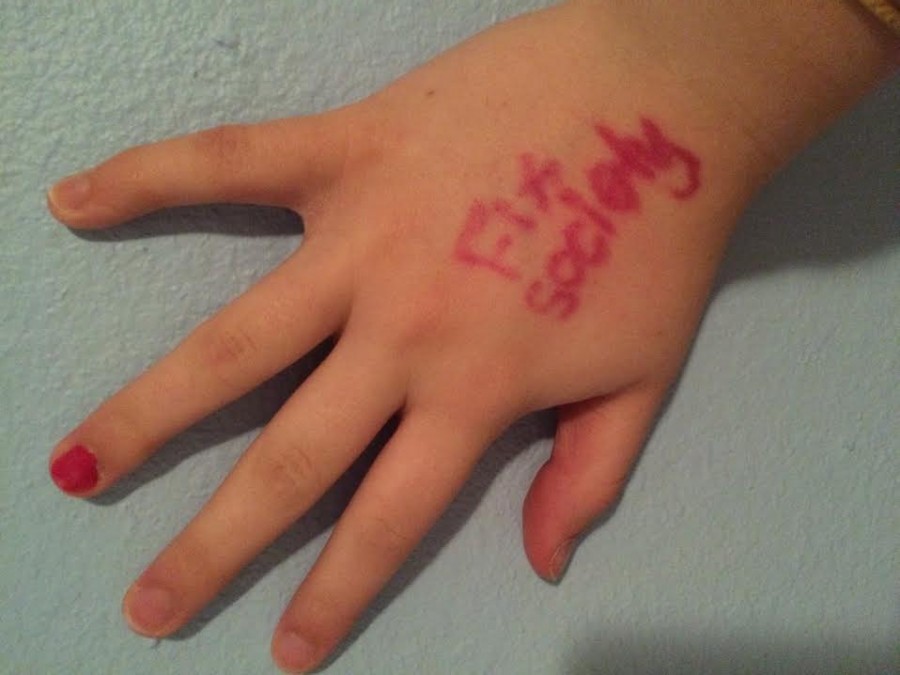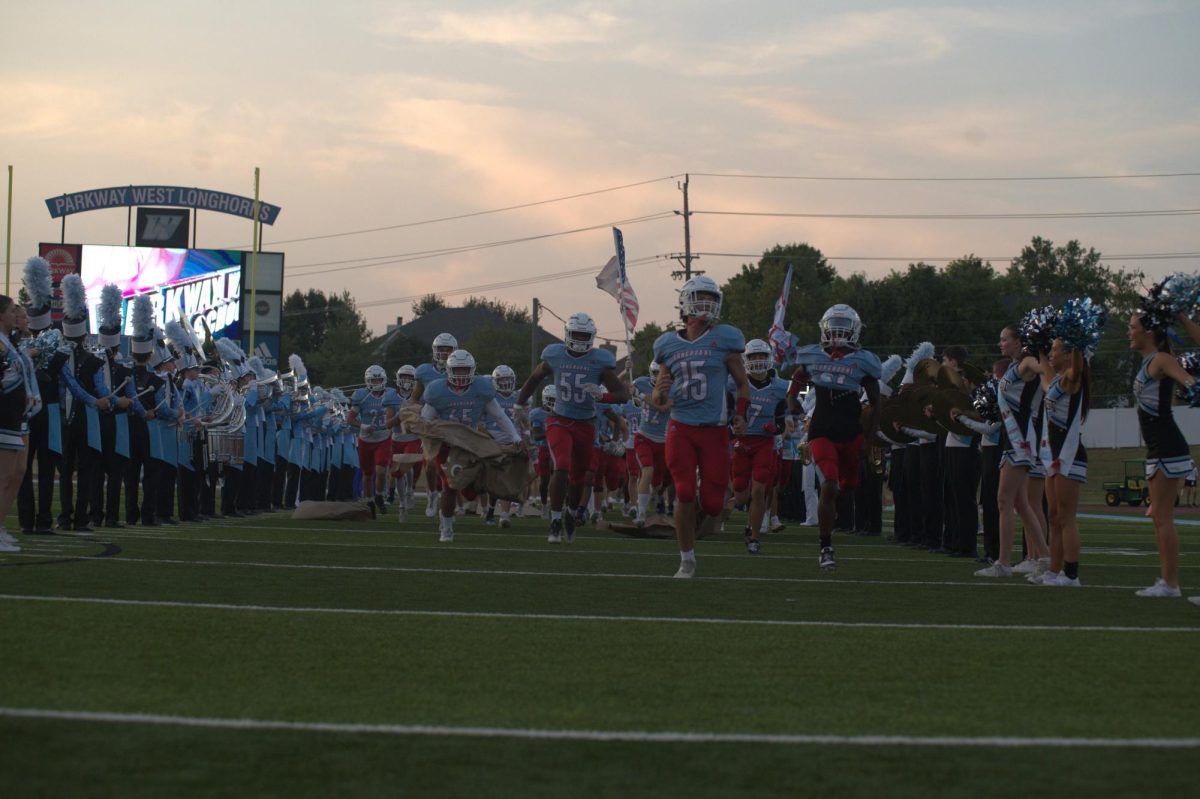Sitting down during the pledge of allegiance. Pink fingernails. Students not uttering a single word for all six hours of the school day. Anything in common here? If you said no, you are far from alone in that thought: many students and teachers have never noticed the “silent” protesting done in classrooms.
So far this year, students have taken part in two silent protests; the first of these, Pink for Leelah, had protesters paint their ring fingernails pink in support of transgender rights after the suicide of Leelah Alcorn.
“I have participated in painting my nails for Leelah,” freshman Gabby Kuster said. “I think out loud [protesting] may have a little more of an effect because it gets your opinion out there, but having the silent protest helps make your point; you’re showing that you would go far for your cause.”
These protests provide an outlet for students to voice their opinions on current social issues without causing a classroom disruption.
“Adults can petition their elected leaders, donate time and funds to causes that they support. Teenagers have school. It is your social milieu and the place where you can express your views and come to understand those whose views differ from your own,” English teacher Michelle Kerpash said.
While Kerpash has never seen students silently protest, she regularly gives her students opportunities to discuss and share thoughts on current social issues in class.
“In a classroom discussion there are many views, often ones that each student has not considered,” Kerpash said. “When there is a strong sense of community in a class, I think it can be a good time and place for those difficult conversations to happen. It seems that there is already a feeling of respect and tolerance for one another’s views in those cases.”
The events in Ferguson increased support for another form of silent protest: sitting during the Pledge of Allegiance. Reasons for not standing include religious ties in the pledge, an opposition to various American governmental issues, racism within the country and more.
“I regularly do not stand for the pledge of allegiance,” freshman Katie English said. “After the grand jury decided there would be no indictment for Darren Wilson and the events that came after, I decided I’m not going to support The United States until the United States supports and respects everyone.”
But several of the students who participated in the first pledge sit-down protesting Wilson’s non-indictment have found other motivations to continue sitting.
“The first thing an elementary schooler is taught is the pledge of allegiance, in elementary school they say it every day. They’re teaching children to recite their loyalty to a country and develop an almost nationalist pride in The United States, when they don’t even know what it means,” English said. “The pledge of allegiance isn’t about supporting your country, it’s about vowing to never speak out against ‘your country.’”
Apr. 17 marks a third silent protest, Day of Silence, which takes the idea of silent protesting much more literally.
“Day of Silence is a national day in the spring during which students pledge to remain silent all day to draw attention to the devastating silencing effects of bullying towards LGBTQ teens,” Kerpash said. “In our building, it is usually sponsored by GSA (Gay Straight Alliance) and has many participants. They typically have a card of some sort that explains their silence.”
But can a silent protest really be beneficial when the majority of the student body has never noticed it happening? To those who participated, the type of protest is not the important part.
“All protests are effective,” English said. “People have the right to express their disagreement with the government and society’s choices whether that be silently or out loud.”
And as classrooms open up to more discussion between peers, understanding between students follows suit.
“I think a lot of times teachers and schools tend to shy away from speaking on social issues just because I think a lot of tension can rise,” English said. “But the only way to ease that tension is if conversations on social issues become more prominent and encouraged.”



![Gazing up from the stage, junior Joseph McCurdy who played Peter Pan in the school play, Lost Girl, sits next to senior Juliana Rogers, who plays Wendy Darling, during a theater rehearsal. McCurdy’s passion for theater began when he observed a West High production in middle school. “I've been in the high school theater program since I was a freshman. I've always loved theater, but [what prompted me to join] was [when] I went to see [a performance here] when I was in middle school, and it was super cool,” McCurdy said.](https://pwestpathfinder.com/wp-content/uploads/2025/11/IMG_6535-1200x798.jpeg)

![Standing tall, stacked in a precise formation, the cheer team strikes a signature pose during halftime on Sept. 12 at the varsity football game. Nearly a month after this performance, the cheer team performed at the Missouri Cheerleading Coaches Association (MCCA) regional competition on Oct. 4, 2025. “We've all come [to] work together a lot more,” sophomore Elyssa Philippi said. “We're a lot closer than we were [earlier in the season] and going to state has made us closer [in] trying to work with each other, learn [new] skills and make our team better.”](https://pwestpathfinder.com/wp-content/uploads/2025/11/DSC5139-1.jpg)
![Handing out candy to excited trunk-or-treaters, President of the United Nations Children’s Fund club and junior Sara Ashok represents that group. Ashok was eager to participate in this event for multiple reasons. “I really wanted to be a part of the event because I get to help create memories for kids and spend time with my friends, spreading the things [I'm passionate about],” Ashok said.](https://pwestpathfinder.com/wp-content/uploads/2025/11/DSC_8648-1-1200x800.jpg)

![Smiling in a sea of Longhorns, Fox 2 reporter Ty Hawkins joins junior Darren Young during the morning Oct. 3 pep rally. The last time West was featured in this segment was 2011. “[I hope people see this and think] if you come to [Parkway] West, you will have the time of your life because there are so many fun activities to do that make it feel like you belong here. I was surprised so many people attended, but it was a lot of fun,” Young said.](https://pwestpathfinder.com/wp-content/uploads/2025/10/Edited2-1200x798.jpg)
![West High seniors and families listen as a representative of The Scholarship Foundation of St. Louis, Teresa Steinkamp, leads a Free Application for Federal Student Aid (FAFSA) workshop. This session, held in the library, provided guidance on financial aid, scholarships and student loan options. “This event is very beneficial for any seniors who are applying to or considering applying to colleges after high school [because] the cost of college is on the rise for seniors and parents,” college and career counselor Chris Lorenz said.](https://pwestpathfinder.com/wp-content/uploads/2025/09/DSC_4478-1200x778.jpg)
![Senior Kamori Berry walks across the field during halftime at the Homecoming football game on Sept. 12. During the pep assembly earlier that day, she was pronounced Homecoming Queen. “I thought it was nice that the crowd [started] cheering right away. I know [my friends] were really excited for me, and my family was happy because typically non-white people don't win,” Berry said.](https://pwestpathfinder.com/wp-content/uploads/2025/09/DSC7046-Enhanced-NR-1200x798.jpg)



![Sophomore Shree Sikkal Kumar serves the ball across the court in a match against Lindbergh. Sikkal Kumar has been a varsity member of the varsity girls’ tennis team for two years, helping her earn the number two rank in Class 2 District 2.“When matches are close, it’s easy to get nervous, but I [ground] myself by[staying] confident and ready to play,” Sikkal Kumar said.](https://pwestpathfinder.com/wp-content/uploads/2025/11/DSC2801-1200x798.jpg)
![Dressed up as the varsity girls’ tennis coach Katelyn Arenos, senior Kate Johnson and junior Mireya David hand out candy at West High’s annual trunk or treat event. This year, the trunk or treat was moved inside as a result of adverse weather. “As a senior, I care less about Halloween now. Teachers will bring their kids and families [to West’s Trunk or Treat], but there were fewer [this year] because they just thought it was canceled [due to the] rain. [With] Halloween, I think you care less the older you get,” Johnson said.](https://pwestpathfinder.com/wp-content/uploads/2025/10/DSC00892-1-1200x800.jpg)
![Focused on providing exceptional service, sophomore Darsh Mahapatra carefully cleans the door of a customer’s car. Mahapatra has always believed his customers deserve nothing less than the best. “[If] they’re trusting us with their car and our service, then I am convinced that they deserve our 100 percent effort and beyond,” Mahapatra said.](https://pwestpathfinder.com/wp-content/uploads/2025/10/DSC_0018-1200x800.jpg)
![Sophomore Aleix Pi de Cabanyes Navarro (left) finishes up a soccer game while junior Ava Muench (right) warms up for cross country practice. The two came to Parkway West High School as exchange students for the 2025-2026 school year. “The goal for the [exchange] program is to provide opportunities for both Parkway students and our international exchange students to learn about other cultures, build connections and become confident, capable, curious and caring — Parkway’s Four C’s — in the process,” Exchange Program Lead Lauren Farrelly said.](https://pwestpathfinder.com/wp-content/uploads/2025/10/Feature-Photo-1200x800.png)
![Leaning on the podium, superintendent Melissa Schneider speaks to Parkway journalism students during a press conference. Schneider joined Parkway in July after working in the Thompson School District in Colorado. “My plan [to bond with students] is to get things on my calendar as much as possible. For example, being in [classes] is very special to me. I am trying to be opportunistic [meeting] kids [and] being in [the school] buildings. I have all the sports schedules and the fine arts schedules on my calendar, so that when I'm available, I can get to them,” Schneider said.](https://pwestpathfinder.com/wp-content/uploads/2025/09/IMG_5425-1200x943.jpeg)
![Gazing across the stage, sophomore Alexis Monteleone performs in the school theater. The Monteleone family’s band “Monte and the Machine” has been releasing music since 2012, but Alexis started her own solo career in 2024 with the release of her first single, Crying Skies. “My whole family is very musical, [and I especially] love writing [songs with them],” Monteleone said.](https://pwestpathfinder.com/wp-content/uploads/2025/09/DSC7463-1200x798.jpg)
![Leaping through the air, senior Tyler Watts celebrates his first goal of the season, which put the Longhorns up 1-0 against the Lafayette Lancers. Watts decided to play soccer for West for his last year of high school and secured a spot on the varsity roster. “[Playing soccer for West] is something I had always dreamed of, but hadn’t really had a good opportunity to do until now. It’s [really] fun being out [on the field], and I’m glad I decided to join the team. It’s just all about having fun with the boys and enjoying what time we have left together,” Watts said.](https://pwestpathfinder.com/wp-content/uploads/2025/09/DSC_1951-1200x855.jpg)

![Shifting global trade, President Donald Trump’s tariffs are raising concerns about economic stability for the U.S. and other countries alike. “[The tariffs are] going to pose a distinct challenge to the U.S. economy and a challenge to the global economy on the whole because it's going to greatly upset who trades with who and where resources and products are going to come from,” social studies teacher Melvin Trotier said.](https://pwestpathfinder.com/wp-content/uploads/2025/05/MDB_3456-1200x800.jpg)

